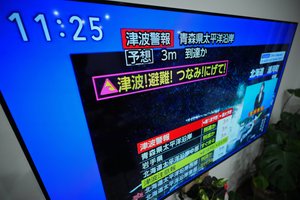August 8, 2023 at 13:35 JST
 A woman uses a parasol to shield herself from the sun’s rays and avoid heatstroke. (Masaru Komiyaji)
A woman uses a parasol to shield herself from the sun’s rays and avoid heatstroke. (Masaru Komiyaji)
Japan has been gripped by sweltering summer heat, and actions are needed to protect the lives and health of people living in today’s world.
At the same time, efforts to curb global warming should be stepped up for the future health of the planet.
Japan just had the hottest July in recorded history. Scorching heat waves have been sweeping the world.
“Climate change is here. It is terrifying. And it is just the beginning,” warned United Nations Secretary-General António Guterres, who declared “the era of global boiling has arrived.”
Guterres called for “dramatic, immediate climate action” by countries.
In recent years, it has become possible to quickly calculate how the rising temperature of the Earth is causing climate disasters by using supercomputers.
Climate scientists conduct analyses of whether and how climate change is contributing to the intensity and frequency of extreme weather such as torrential rain and violent heat by using modeling that simulates the likelihood and intensity of the weather event.
In their analyses, scientists utilize two "worlds": today’s world with global warming, and a hypothetical world without human-caused climate change.
They compare observations of current weather to repeated computer simulations of “a world that might have been without climate change.”
A group of climate scientists recently said their study using this technique shows the heat waves that simultaneously broiled the southwestern United States and southern Europe this summer would have been “virtually impossible” if it were not for global warming.
It is crucial for the entire world to confront the grim reality of climate change and tackle the challenge head-on.
A report released this year by the U.N. Intergovernmental Panel on Climate Change (IPCC) warned that the world is likely to pass a dangerous temperature threshold--limiting warming to 1.5 degrees Celsius above preindustrial temperatures--within the next 10 years.
With a temperature rise of 1.5 degrees, heat waves of the sort that occurred once in 10 years on average in a climate without human influence would likely occur 4.1 times more frequently, according to the report.
But the temperature has already risen 1.1 degrees and the increase will surpass the 1.5 degrees mark by 2030 if greenhouse gases continue being emitted at the current rate.
“The choices and actions implemented in this decade will have impacts now and for thousands of years,” the report said.
There are two categories of measures to deal with challenges linked to climate challenge--adaptation and mitigation.
The former type of measures are basically responses to the phenomena of the increase in world temperatures caused by greenhouse gases, while the latter are steps to stem the warming of the planet.
During a spate of blistering heat, it is vital to keep the body hydrated and stay cool by using air conditioning properly. It also helps to build a society that allows avoiding going outside during the hottest time of the day as much as possible.
It is also critical to expedite efforts for mitigation for our and our offspring's futures. This means trying harder to reduce the global emissions of greenhouse gases by expanding the use of renewable energy.
But progress in slashing heat-trapping gasses has been glacial. Changes in the global energy situation due to Russia’s aggression against Ukraine have only worsened things.
Japan’s decarbonization policy has been focused on ramping up nuclear power generation. But it would be a mistake to remain dependent on atomic energy because of the many tough challenges involved, including risks of serious nuclear accidents and disposal of radioactive waste.
Experts have pointed to problems related to use of renewable energy sources, such as negative impacts on wild animals and greater landslide risks. But there is still much that can be done.
There is, for example, much room for installing solar panels onto buildings and houses and in abandoned farmland. Researchers are working on the technologies to develop thin film solar cells that can be installed on wider kinds of surfaces.
There have been growing cases where major electric utilities required to purchase output from renewable energy facilities through the feed-in tariff (FiT) system temporarily halt electricity produced from solar sources from feeding into the grid due to limited grid capacity.
It is urgently needed to create effective systems to store power generated by clean energy and enhance the capacity of the transmission and distribution networks.
Locally produced electricity from solar and wind power also helps improve the nation’s preparedness for natural disasters. All-out efforts should be made to ensure rapid expansion of renewable energy that is produced in Japan.
--The Asahi Shimbun, Aug. 7




















A peek through the music industry’s curtain at the producers who harnessed social media to help their idols go global.
A series based on diplomatic documents declassified by Japan’s Foreign Ministry
Here is a collection of first-hand accounts by “hibakusha” atomic bomb survivors.
Cooking experts, chefs and others involved in the field of food introduce their special recipes intertwined with their paths in life.
A series about Japanese-Americans and their memories of World War II